Ovid's Metamorphoses and Further Metamorphoses discussion
The Metamorphoses - The 15 Books
>
Book Two - 19th November 2018
 Roger wrote: "But did Jupiter make her pregnant, and if so, who were her offspring? "
Roger wrote: "But did Jupiter make her pregnant, and if so, who were her offspring? "She definitely gave birth to Minos, Rhadamanthus and Sarpedon who later became the judges in the underworld - they are the sons of Jupiter/Zeus. But she might well have other offspring - these mythic genealogical tables are notoriously tangled!
 Roman Clodia wrote: "
Roman Clodia wrote: "One of the most explicit Europa images with the bull, based on an Athenian vase c.480 bce."
This is wonderful.... Modern artists invented little..
 Fionnuala wrote: "Just to say I'm following the discussion with much interest — and viewing the art with great pleasure."
Fionnuala wrote: "Just to say I'm following the discussion with much interest — and viewing the art with great pleasure."Waving back....!!!!
:)
Thank you for identifying yourself amongst the readers...!!!
 Roman Clodia wrote: "The Europa story also gives the etymology of 'Europe', the continent: she is a princess of Sidon, a Phoenician city on the eastern side of the Mediterranean, and is carried by Jupiter to Crete (I t..."I love eavesdropping in museums: at Knossos I overheard a good German father explaining the story of Europa to his children, he connected the bull in the labyrinth on Crete with the Europa story in Ovid, and made her the mother of the EU...
Roman Clodia wrote: "The Europa story also gives the etymology of 'Europe', the continent: she is a princess of Sidon, a Phoenician city on the eastern side of the Mediterranean, and is carried by Jupiter to Crete (I t..."I love eavesdropping in museums: at Knossos I overheard a good German father explaining the story of Europa to his children, he connected the bull in the labyrinth on Crete with the Europa story in Ovid, and made her the mother of the EU...
 Before leaving book two, one comment on the Aglauros story: I've just finished the biography of Rene Girard, a Stanford philosopher who considered Envy to be the driving force of human behavior, he called it mimesis, but his theories are all about jealousy...and reading the description of Envy in her cave as she devours vipers for dinner and drips gall and poison so reminded me that the ancients knew all about the effects of envy...just glad we are viewing images of lovely Europa and not Envy...
Before leaving book two, one comment on the Aglauros story: I've just finished the biography of Rene Girard, a Stanford philosopher who considered Envy to be the driving force of human behavior, he called it mimesis, but his theories are all about jealousy...and reading the description of Envy in her cave as she devours vipers for dinner and drips gall and poison so reminded me that the ancients knew all about the effects of envy...just glad we are viewing images of lovely Europa and not Envy...
 Roger wrote: "The Greeks have (or had) a relief of Europa and the bull on their 2 Euro coin. R.
Roger wrote: "The Greeks have (or had) a relief of Europa and the bull on their 2 Euro coin. R."
Yes, a bit ironic.. given what happened in 2012.
 Elena wrote: " I've just finished the biography of Rene Girard, a Stanford philosopher who considered Envy to be the driving force of human behavior, he..."
Elena wrote: " I've just finished the biography of Rene Girard, a Stanford philosopher who considered Envy to be the driving force of human behavior, he..."That sounds like a good book. I enjoyed the Envy episode in spite of everything. I counted about 12 times in which a term related to eyesight is mentioned.
I posted an image in Comment #107.
Another famous depiction of this Vice, but not related to Ovid is Giotto's in the Scrovegni Chapel.

 The Europa theme is inexhaustible.
The Europa theme is inexhaustible.Here is another very different rendition.
Rembrandt. 1632. J. P. Getty.

It was commissioned by a Member of the Dutch East India company. Hence the emphasis on the port, and this allegorical transport in the sea... Haha..
 Yes, I've been toying with posting this Rembrandt myself, but there is so, so much, and this one seems especially unclassical. Which is precisely its interest, of course! It all seems so bourgeois, doesn't it? One wonder what Jupiter sees in this Europa—yet of course she is a familiar Dutch type, and presumably attractive by the standards of her time. Detail below. R.
Yes, I've been toying with posting this Rembrandt myself, but there is so, so much, and this one seems especially unclassical. Which is precisely its interest, of course! It all seems so bourgeois, doesn't it? One wonder what Jupiter sees in this Europa—yet of course she is a familiar Dutch type, and presumably attractive by the standards of her time. Detail below. R.
 I have just finished reading The Rape of Europa: The Intriguing History of Titian's Masterpiece and he has an interesting passage.
I have just finished reading The Rape of Europa: The Intriguing History of Titian's Masterpiece and he has an interesting passage.He mentions another Greek text, The Adventure of Leucippe and Clitophon by Achilles Tatius. In this work there is ekphrastic description of a painting on Europa.
And I quote from Fitzroy:
What is interesting in his description of this painting is the number of details it contains which appear in Titian's painting: Europa's drapery blowing in the wind, and the cupids that accompany her, flying through the air and swimming in the sea.
The drapery blowing in the wind is in Ovid, but the cupids are not. I wonder about the Dolphins.
Then Fitzroy says that the Spanish ambassador to Venice, Diego Hurtado de Mendoza, and who mediated in the correspondence between Titian and Philip II, owned a copy of Achilles Tatius book.
May be RC knows about this..
I wonder about the dolphins. An important element and that Serov included.
So a painting based on a text about a painting...
 Well, the Rembrandt had more of a moral message and a particular one also - related to the patron who commissioned it.
Well, the Rembrandt had more of a moral message and a particular one also - related to the patron who commissioned it.For a good contrast we can now go to:
Boucher. 1732-34. Wallace Collection.

Look at the pampered Bull... Not altogether white. It is not just Europa enjoying the company of the animal.. all her companions are also delighted.
I am soon beginning to read Casanova's Memoirs, so I guess I'd better get used to Boucher's world.
 The Boucher makes me think of Bottom in Titania's bower being waited on by her fairy attendants.
The Boucher makes me think of Bottom in Titania's bower being waited on by her fairy attendants. I did a tiny amount of reading on Titian and his Ovidian paintings, and remember being surprised that he didn't know Latin and so relied on other people to translate Ovid for him.
I've been meaning to read Leucippe and Clitophon for ages - it's only short, so now might be a good time.
 I have been looking at a bunch of Europa sculptures. There is a wide range here, from heroic to Kitsch. But leaving aside the latter, one of the things that strikes me is how the stone or metal gives the character strength. Many of these show Woman Empowered, and few if any have a helpless victim.
I have been looking at a bunch of Europa sculptures. There is a wide range here, from heroic to Kitsch. But leaving aside the latter, one of the things that strikes me is how the stone or metal gives the character strength. Many of these show Woman Empowered, and few if any have a helpless victim.Anyway, just to get them off my desktop, here is a baker's dozen arranged in rough chronological order. I haven't time to do exact dates and attributions, nor will I comment in detail.
Further comments would be welcome. R.
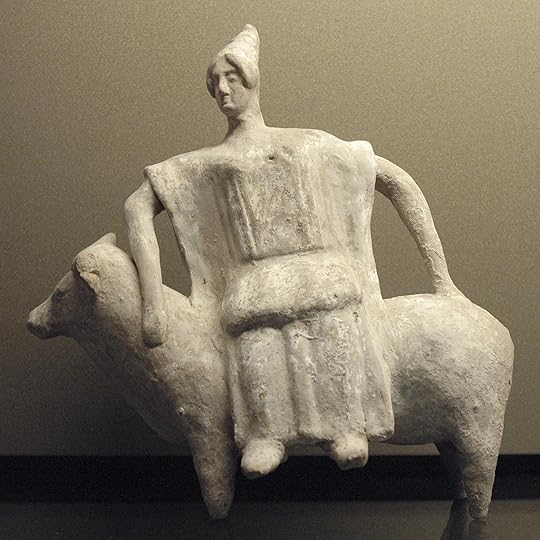
1. Greek, 470–450 BCE. Louvre.
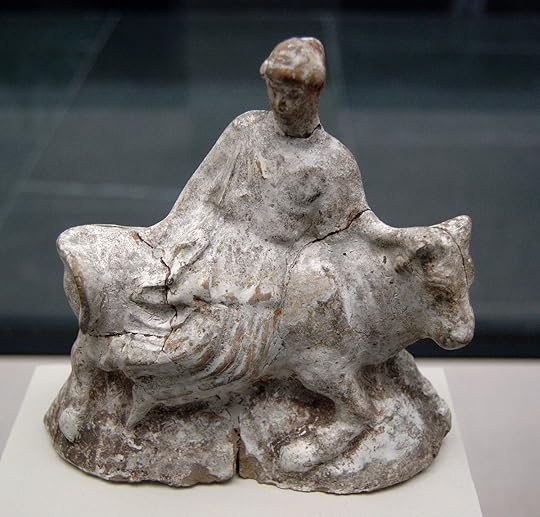
2. Terracotta, c. 470 BCE. Munich.
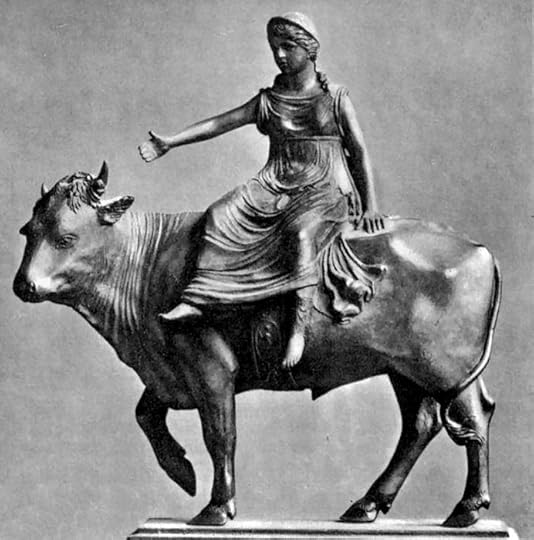
3. Bartolomeo Bellano, later 15th century.

4. Riccio, 1500. Budapest.
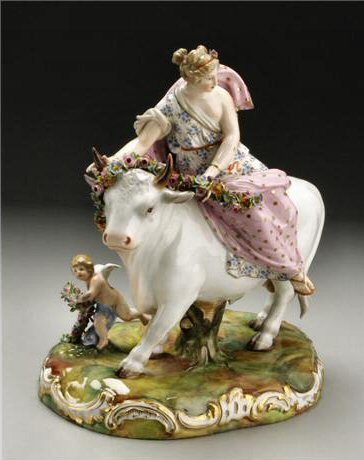
5. Meissen figurine, later 19th century.

6. Carl Milles, c. 1925. Cranbrook College. An unusually heroic Europa.

7. Lilli Finzelberg, 1930. Hamburg. Presented to the captain of the maiden voyage of the EUROPA.

8. Jacques Lipschitz, 1938.

9. Ruben Nakian, 1975.
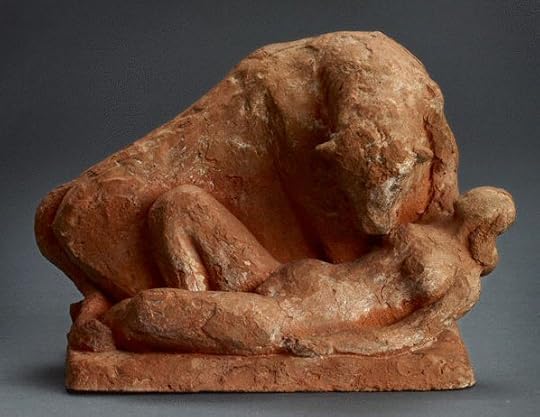
10. Frank Dobson, 1946. I love its tenderness.

11. Asajero, 20th century. I can find out nothing about the sculptor, but include it as one of a very large number of such works, from the Art Deco period on, that emphasize the elegance of the Europa figure.

12. Fernando Botero. Contemporary. Don't ask me!
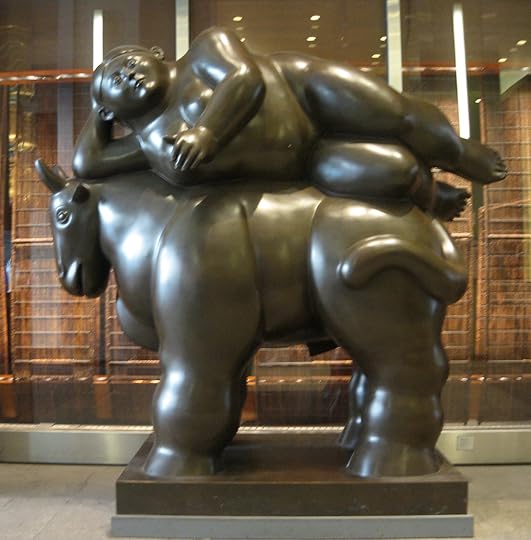
13. Fernando Botero. Contemporary.
 Kalliope wrote: "The drapery blowing in the wind is in Ovid, but the cupids are not. I wonder about the Dolphins."
Kalliope wrote: "The drapery blowing in the wind is in Ovid, but the cupids are not. I wonder about the Dolphins."I have posted a query about cupids and so on before, but nobody picked up on it. My interest then was the similarity of the cupids to the putti accompanying Christian art.
In this case, the presence of the cupids presumably sanctifies the occasion as a romance rather than a rape. The dolphins are standard imagery to show that the demigods of the sea also lent their support. I imagine that, while Titian was very largely initiating a new pattern, most later artists were influenced by the art that came before them, rather than by their own readings of this or any other text. R.
 Roger wrote: "Callisto Paintings: heroic, and not so much
Roger wrote: "Callisto Paintings: heroic, and not so muchI might as well post the great Titian painting of Diana discovering Callisto's pregnancy, one of the seven "poesies," or scenes from Ovid, painted for P..." One more note on Callisto: I love the painting attributed to Kauffmann, it brings out the theme of the double. Both Diana and Callisto have quivers with arrows, are almost twins. Kathleen Wall, I think it was, claims Artemis was not originally a virgin goddess, and Callisto retains the memory of an aspect of Artemis that got deleted as patriarchy became more entrenched...
 Thanks for this, Elena. I like the Kauffman too, because it makes the two look like pupils in a boarding school, maybe a prefect encouraging a promising youngster. However, I do not understand your point about Callisto retaining a memory of some prior version of Artemis/Diana (who is really Zeus/Jupiter anyhow). R.
Thanks for this, Elena. I like the Kauffman too, because it makes the two look like pupils in a boarding school, maybe a prefect encouraging a promising youngster. However, I do not understand your point about Callisto retaining a memory of some prior version of Artemis/Diana (who is really Zeus/Jupiter anyhow). R.
 Roger wrote: "I have been looking at a bunch of Europa sculptures. There is a wide range here, from heroic to Kitsch. But leaving aside the latter, one of the things that strikes me is how the stone or metal giv..."
Roger wrote: "I have been looking at a bunch of Europa sculptures. There is a wide range here, from heroic to Kitsch. But leaving aside the latter, one of the things that strikes me is how the stone or metal giv..."I really have nothing to say except to thank you for having put together such an excellent collection of photos.
The first two pictures are of sculptures that were made before Ovid wrote his work. It is unlikely however that we would be looking at them with the same interest if it had not been Ovid who is still the true starting point of the tradition.
 Czarny wrote: "The first two pictures are of sculptures that were made before Ovid wrote his work."
Czarny wrote: "The first two pictures are of sculptures that were made before Ovid wrote his work."Thanks, Czarny. It is just by chance that two of the three moderators are renegade art historians. You are of course right that we are reading because of Ovid, and the first two sculptures are pre-Ovidian. But what this has helped me realize—though perhaps it is obvious to others—is that Ovid himself was metamorphosing earlier myths. He emphasizes a narrative, even sometimes a romantic aspect. But some of the most seminal myths—and it seems that Europa is one—encapsulate more basic truths that we then see reflected in parallel with his telling of the stories. R.
 I found the dolphins:
I found the dolphins:Europa: GreekMythology.com - Dec 03, 2018
“The bull laid down in front of Europa and she slid onto its back. Instantly, the bull charged off, plunging into the sea, and began to swim rapidly from the shore. Europa saw that a procession had joined them, Nereids riding dolphins, Triton blowing his horn, even Poseidon. From this, she realized that the bull must be a god and she pleaded to pity her. Zeus spoke to her and explained his love. He took her to Crete, where he had been raised, and promised her that she would bear him many famous sons. Her sons included Minos and Rhadamanthus.“
Caution: this site does not cite sources. It features ads and click bait. However, quick reference info well written and helpful
 Roman Clodia wrote: "
Roman Clodia wrote: "I did a tiny amount of reading on Titian and his Ovidian paintings, and remember being surprised t..."
But Titian hanged around with very literal people, Ariosto being a close friend.
In the correspondence with both Charles V and his son Philip II, Titian referred to the series of paintings the monarchs were commissioning as 'poesia' and 'fabula', thereby stressing the link between the plastic and literary arts, the creativity of the artist, and the disassociation of painting from the manual arts.
Checking material on the 'poesia' series in the Prado, they state that Titian's 'Europa on a Bull' was based mostly on the Leucippe and Clitophon, but they also stress that Titian would try to go beyond the text too, arguing for his own creative powers. (They stressed this particularly with another of the paintings in the series, the Venus & Adonis).
I have just downloaded it. I may read now just the Europa section and leave the rest for later.
 The text by Achilles Tatius can be downloaded very cheaply:
The text by Achilles Tatius can be downloaded very cheaply:https://www.amazon.com/Adventures-Leu...
The Europa passage is at the very beginning and it is short.
Several things strike me:
1. The ekphrastic quality which I mentioned above. This is a description of a painting of Europa, not the actual story. So what we have is Titian rendering back to painting a textual description of another painting and from the classical times.
2. Emphasis on the landscape. This would take us to the rendering by the Northern painters, with Rembrandt being one of them. Will look for more.
3. It does not correspond exactly to Titian, but the Dolphins and Cupids are there, with Eros himself taking a leading role and given an unequivocal romantic tone to the representation. No violence - just surprise.
In case not everyone downloads the book, I will give a quote:
.. her figure could be traced under the clothes -- the deep-set navel, the long slight curve of the belly, the narrow waist, broadening down to the loins, the breasts gently swelling from her bosom and confined, as well as her tunic, by a girdle: an the tunic was a kind of mirror of her body. Her hands were held widely apart, the one to the bull's horn, the other to his tail; and with both she held above her head the ends of her veil which floated down about her shoulders, bellying out through its whole length and so giving the impression of a painted breeze. Thus she was seated on the bull like a vessel under way, using the veil as a sail; about the bull dolphins gambolled, Cupids sported: they actually seemed to move in the picture, Love himself led the bull -- Love, in the guise of a tiny boy, his wings stretch out, wearing his quiver, his lighted torch in his hands: he was turning towards Zeus with a smile on his face, as if he were laughing at him for becoming a bull for his sake.
As said before, the Ambassador who was mediating in the negotiations of this commission, had a copy of this book. He came from a very literary family (in fact a portrait of one of his ancestors, a writer, figures on the cover of school textbooks on Spanish literature).
 Historygirl wrote: "I found the dolphins:
Historygirl wrote: "I found the dolphins:Europa: GreekMythology.com - Dec 03, 2018
“The bull laid down in front of Europa and she slid onto its back. Instantly, the bull charged off, plunging into the sea, and began..."
Thank you, Historygirl, when I read your quote I thought it could come from the Leucippe, but it must be yet another source.
 Roger wrote: "I have been looking at a bunch of Europa sculptures. There is a wide range here, from heroic to Kitsch. But leaving aside the latter, one of the things that strikes me is how the stone or metal giv..."
Roger wrote: "I have been looking at a bunch of Europa sculptures. There is a wide range here, from heroic to Kitsch. But leaving aside the latter, one of the things that strikes me is how the stone or metal giv..."Thank you for the sculptures, Roger.
My favourites are: 1, 2, 8 and 10.
Alas, I am not fond of Botero...
:(
 Kalliope wrote: "Alas, I am not fond of Botero..."
Kalliope wrote: "Alas, I am not fond of Botero..."I neither. But I included him as an example of how totally an iconic image may be changed.
I agree with your favorites among the sculptures, at least #1, #2, and #10. I do have a sneaking fondness for that Meissen (#5), and am so puzzled by the violence of the Ricci (#4) that I wonder if Europa is even the correct attribution.
I am very struck by the recent correspondence between Historygirl, Roman Clodia, and yourself. I shall look at the Tatius when I get the chance. I think that, with our focus on Ovid, we just assumed that his text would be the source of any painting of stories that he tells. But clearly not necessarily so. And the ekphrasis adds a fascinating layer. R.
 Roger wrote: "I have been looking at a bunch of Europa sculptures. There is a wide range here, from heroic to Kitsch. But leaving aside the latter, one of the things that strikes me is how the stone or metal giv..."
Roger wrote: "I have been looking at a bunch of Europa sculptures. There is a wide range here, from heroic to Kitsch. But leaving aside the latter, one of the things that strikes me is how the stone or metal giv..."What a contrast between the Bellano and the Riccio, Roger, though they may only be decades apart.
I really like the violence of the Europa figure in the Riccio. Take that, and that and that, you monstrous beast!
 Roger wrote: "Czarny wrote: "The first two pictures are of sculptures that were made before Ovid wrote his work."
Roger wrote: "Czarny wrote: "The first two pictures are of sculptures that were made before Ovid wrote his work."Thanks, Czarny. It is just by chance that two of the three moderators are renegade art historian..."
The authors that I read have called Ovid the first synthesist. Bullfinch, Edith Hamilton, and Robert Graves all came after him. To my view, Ovid's great contribution was to unite several mythological traditions that were culturally and geographically disparate into a unified vision of the world.
This much said I am deeply grateful to the other GR members who have taken the time to find and present paintings inspired by Ovid.
 Kalliope wrote: "Well, the Rembrandt had more of a moral message and a particular one also - related to the patron who commissioned it.
Kalliope wrote: "Well, the Rembrandt had more of a moral message and a particular one also - related to the patron who commissioned it.For a good contrast we can now go to:
Boucher. 1732-34. Wallace Collection.
..."
The excellent responses with outstanding illustrations by the group members are an absolute delight to read and view. Thank you for this and several excellent contributions to the thread.
 Kalliope wrote: "Another rendering which I saw not too long ago, is Veronese.
Kalliope wrote: "Another rendering which I saw not too long ago, is Veronese. He puts the emphasis on the seduction scene, rather than the 'kidnapping'. Europa is fascinated by the beauty of the bull and has, so ..."
Kalliope, you have really started a remarkable thread. Your own contributions and choices of illustrations have been excellent.
 Roger wrote: "am so puzzled by the violence of the Ricci (#4) that I wonder if Europa is even the correct attribution.."
Roger wrote: "am so puzzled by the violence of the Ricci (#4) that I wonder if Europa is even the correct attribution.."roger, I was also puzzled by Riccio's Europa, and now that Fionnuala has picked it up and given a short dialogue to her, I have gone to look it up.
From the link below, which identifies a different source, an Ode by Horace, I am copying the relevant extract:
In the oft-depicted Ovidian version of the story however there is no mention of the pugnacious resistance apparent in the Budapest small bronze. In Ovid's Metamorphoses the princess was quite taken by the overtures made to her by Zeus turned bull. It is likely, then, that the author of the Budapest sculpture took inspiration not from this popular work, but from a less well known ode by Horace, in which the Roman poet writes of Europa's desperate protestations.
https://artsandculture.google.com/ass...
 So the Riccio is inspired by Horace? Thanks for checking on that, Kalliope. I might read the Horace Ode..
So the Riccio is inspired by Horace? Thanks for checking on that, Kalliope. I might read the Horace Ode..
 I found a reference to the Horace Ode also, on an interesting website that I shall send you when I get home (I'm just about to teach a class on C19 French realism). But the citation must be wrong, since I could not find it, at least in Latin. If you track it down, please post a link or, better still, a translation of the relevant passage into some modern language. R.
I found a reference to the Horace Ode also, on an interesting website that I shall send you when I get home (I'm just about to teach a class on C19 French realism). But the citation must be wrong, since I could not find it, at least in Latin. If you track it down, please post a link or, better still, a translation of the relevant passage into some modern language. R.
 Roman Clodia wrote: "Just a quickie, it's Horace Odes, book 3, poem 27"
Roman Clodia wrote: "Just a quickie, it's Horace Odes, book 3, poem 27"Thank you, RC. I don't know why I couldn't find it before. I was having a hard time with the Latin, but found a translation in the website Poetry in Translation. It is quite wonderful! I give the central stanzas (about a third of the whole) below. R.
So, Europa entrusted her snow-white form
to the bull’s deceit, and the brave girl grew pale,
at the sea alive with monsters, the dangers
of the deep ocean.
Leaving the meadow, where, lost among flowers,
she was weaving a garland owed to the Nymphs,
now, in the luminous night, she saw nothing
but water and stars.
As soon as she reached the shores of Crete, mighty
with its hundred cities, she cried: ‘O father,
I’ve lost the name of daughter, my piety
conquered by fury.
Where have I come from, where am I going? One
death is too few for a virgin’s sin. Am I
awake, weeping a vile act, or free from guilt,
mocked by a phantom,
that fleeing, false, from the ivory gate brings
only a dream? Is it not better to pick
fresh flowers than to go travelling over
the breadths of the sea?
If anyone now could deliver that foul
beast to my anger, I’d attempt to wound it
with steel, and shatter the horns of that monster,
the one I once loved.
 Roger wrote: "Thanks for this, Elena. I like the Kauffman too, because it makes the two look like pupils in a boarding school, maybe a prefect encouraging a promising youngster. However, I do not understand your..."K. Wall's argument is a bit obscure, but it seems Ovid loved playing with the idea of doubles, and Ovid drew on an older myth where Artemis is called Kalliste. So when Jupiter takes on the image of Diana, he is in a sense pretending to be Callisto's double. Something like that. Anyway, Kauffmann, a rare female artist in her era, does get the business of twins, and split identity...
Roger wrote: "Thanks for this, Elena. I like the Kauffman too, because it makes the two look like pupils in a boarding school, maybe a prefect encouraging a promising youngster. However, I do not understand your..."K. Wall's argument is a bit obscure, but it seems Ovid loved playing with the idea of doubles, and Ovid drew on an older myth where Artemis is called Kalliste. So when Jupiter takes on the image of Diana, he is in a sense pretending to be Callisto's double. Something like that. Anyway, Kauffmann, a rare female artist in her era, does get the business of twins, and split identity...
 Roger wrote: " ..It is quite wonderful! I give the central stanzas (about a third of the whole) below. R.."
Roger wrote: " ..It is quite wonderful! I give the central stanzas (about a third of the whole) below. R.."Thanks to you both, RC and Roger. I was pleased the translation of the ode contained the words monster and beast!
 Yes, thank you for the translation of this ode by Horace, quite wonderful...another thing I would not have found on my own...I pretty much ruined my youth learning German and Russian and forgot to study Latin...and Greek...and Hebrew...
Yes, thank you for the translation of this ode by Horace, quite wonderful...another thing I would not have found on my own...I pretty much ruined my youth learning German and Russian and forgot to study Latin...and Greek...and Hebrew...
 Kalliope (#174) gave the passage in the painting described by Tatius that deals with Europa herself. I want to add the passage with which the description of this painting begins:
Kalliope (#174) gave the passage in the painting described by Tatius that deals with Europa herself. I want to add the passage with which the description of this painting begins:The painting was of Europa: the sea depicted was the Phoenician Ocean; the land, Sidon. On the land part was a meadow and a troop of girls: in the sea a bull was swimming, and on his back sat a beautiful maiden, borne by the bull towards Crete. The meadow was thick with all kinds of flowers, and among them was planted a thicket of trees and shrubs, the trees growing so close that their foliage touched: and the branches, intertwining their leaves, thus made a kind of continuous roof over the flowers beneath. The artist had also represented the shadows thrown by the leaves, and the sun was gently breaking through, here and there, on to the meadow, where the painter had represented openings in the thick roof of foliage. The meadow was surrounded on all sides by an enclosure, and lay wholly within the embowering roof; beneath the shrubs grass-beds of flowers grew orderly—narcissus, roses, and bays; in the middle of the meadow in the picture flowed a rivulet of water, bubbling up on one side from the ground, and on the other watering the flowers and shrubs; and a gardener had been painted holding a pick, stooping over a single channel and leading a path for the water.It's beautiful and extraordinarily detailed. But it only represents a very small part of the subject, equivalent to a strip at the left-hand edge of the Titian, say. Which made me wonder if there was any equivalent in Roman landscapes that have come down to us. Here are three (all Photoshopped to make them readable at this size):

Fresco from Pompeii, C1 CE.

Scene from the Odyssey, C1 BCE, Vatican.
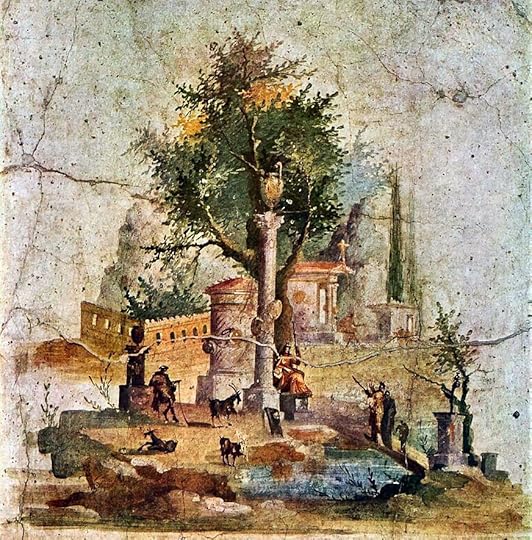
Fresco from Boscotrecase, C1 CE, Naples.
Slim pickings, I'm afraid, although the third of these especially is quite beautiful. Perhaps there were paintings now lost that achieve some of the effects described by Tatius, but I doubt it. You can see the artists aiming for such an effect, but not achieving it in sustained form. A single pool, a pair of trees stand in for the kind of extensive landscape that Tatius describes.
We think of ekphrasis as describing an existing artwork in some other medium. such as poetry or (here) prose. But this makes me wonder if there is not another kind, what you might call ideal-ekphrasis, that uses words to paint the kind of picture that could not be achieved in the art of the time? So it is not "I saw this picture, and here's what it looked like," but "Imagine this, if you can…".
Nothing directly to do with Ovid, of course. But it reminded me that, up to now, we have not looked much at Ovid himself as a landscape painter in words. Yes, he uses shady groves and babbling brooks, the conventional attributes of the locus amoenus, or pleasant place. But the kind of detail given by Tatius? I think not, but may be wrong. This whole excursus has given me an impulse now to look. R.
 Roger wrote: " But this makes me wonder if there is not another kind, what you might call ideal-ekphrasis, that uses words to paint the kind of picture that could not be achieved in the art of the time? So it is not "I saw this picture, and here's what it looked like," but "Imagine this, if you can…". "
Roger wrote: " But this makes me wonder if there is not another kind, what you might call ideal-ekphrasis, that uses words to paint the kind of picture that could not be achieved in the art of the time? So it is not "I saw this picture, and here's what it looked like," but "Imagine this, if you can…". "Another quick comment only: this form of 'ideal-ecphrasis' might usefully describe the shield of Achilles in the Iliad, and Virgil's reimagining of it in his shield of Aeneas in the Aeneid.
 Roger wrote: "In this case, the presence of the cupids presumably sanctifies the occasion as a romance rather than a rape."
Roger wrote: "In this case, the presence of the cupids presumably sanctifies the occasion as a romance rather than a rape."I would hesitate to associate Ovid's Cupid with 'romance' (a culturally-specific term that we can usefully historicise): just think of his aggressive and malicious behaviour at the start of the Daphne and Apollo episode.
Also Ovid's Amores 1.2 has the narrator displayed as a wounded slave in Cupid's triumphal procession - will post links when I'm at my desk.
But yes, this more disputative Cupid of Ovid seems to have become softened, certainly in Renaissance images.
 Roger wrote: "Roman landscapes that have come down to us..."
Roger wrote: "Roman landscapes that have come down to us..."These are wonderful details from Roman paintings, Roger, which reminds me that I was supposed to post some paintings from the Dutch landscapists.
I will do so later today.
 Roman Clodia wrote: " 'ideal-ecphrasis' ..."
Roman Clodia wrote: " 'ideal-ecphrasis' ..."On the 'ideal-ecphrasis', RC and Roger..
Remember the description of the doors in Hellios's palace when Phaeton arrives at the beginning of this book.
It is a beautiful description.
I posted on this above, #8.
 Just following up on aggressive Cupid:
Just following up on aggressive Cupid:Ovid, Amores 1.2.27-30
In your [Cupid's] train shall be captive youths and captive maids; such a procession will be for you a state Triumph. Myself, a recent spoil, shall be there with wound all freshly dealt and bear my new bonds with unresisting heart.
Propertius, 1.1.3-4 (contemporary with Ovid)
It was then that Love made me lower my eyes of stubborn pride and trod my head beneath his feet.
Quite different from all those plump little cute and cuddly cupids in the paintings!
 Here is the Europa of Guido Reni, painted 1638–40 and now in the National Gallery in London. It is quite significantly different from the others:
Here is the Europa of Guido Reni, painted 1638–40 and now in the National Gallery in London. It is quite significantly different from the others:
I am struck by its simplicity: nothing there except Europa, the bull, and one Cupid in the expanse of sea and sky. I am moved by its sweetness. But I am puzzled by the lack of distinction between this pagan subject and Christian art. The costuming, pose, and facial expression of Europa is strongly reminiscent of Raphael's saints, and you see the same thing in some of Reni's own religious pictures, such as the Mary Magdalene here in Baltimore; see the details below:

Erasmus+, the website I mentioned in an earlier post that lists over five dozen Europa images, notes the similarity as
…an intense iconographic parallel in forms and meaning of the classic Myth and the Christian values connected to the rape of the soul towards God to reach celestial beatitude. Reni mixes and transforms sacred and profane in a sort of well-done allegory of the salvation of the human soul.What? And yet John Donne's Holy Sonnet, "Batter my heart, three-person'd God," ends with the same image:
Take me to you, imprison me, for I,I would hesitate to attribute this meaning as the primary intention of Reni's painting, but I am struck nonetheless by how Protean a myth the story of Europa is, usable in the whole gamut of meanings from rape through apotheosis. R.
Except you enthrall me, never shall be free,
Nor ever chaste, except you ravish me.
 And now a contrast. Here is the Europa story as told by English poet Simon Armitage in the collection After Ovid, which is on our group bookshelf. Very straightforward, except for the occasional use of unusual words: stirks, stot, allocked, bezzled, snod, bruff, and so on. Many of them can't be found in a dictionary, though one knows what they mean in context. But their Norse ring suspect that either they are farmyard words in one of the old dialects from the north of England, or are crafted to sound that way. What is interesting is that it brings the story down to the animal level, the opposite of the refinement shown by Titian and others. And yet this too has its pathos.
And now a contrast. Here is the Europa story as told by English poet Simon Armitage in the collection After Ovid, which is on our group bookshelf. Very straightforward, except for the occasional use of unusual words: stirks, stot, allocked, bezzled, snod, bruff, and so on. Many of them can't be found in a dictionary, though one knows what they mean in context. But their Norse ring suspect that either they are farmyard words in one of the old dialects from the north of England, or are crafted to sound that way. What is interesting is that it brings the story down to the animal level, the opposite of the refinement shown by Titian and others. And yet this too has its pathos.Jupiter and Europa
How very like him, Jove,
the father of the skies,
to send his silver son
down on a thread of light
to drive a team of stirks
across the lower slopes
towards the sea. A girl,
Europa, walked on the beach.
Then leaving in a cloud
his three-pronged fork, he went
to ground, dressed as a stot,
a bull, and allocked there
and bezzled with the herd.
His hide was snod and bruff,
a coat so suede and soft
and chamois to the touch,
and white, as if one cut
would spill a mile of milk.
His eyes were made of moon.
His horns were carved in oak.
Europa, capt and feared,
would not go near at first,
then offered to his lips
a posy fit to eat.
Jove nuzzled at her fist,
then ligged down in the sand;
in turns she smittled him
with plants, then climbed his back,
at which he sammed her up
and plodged into the tide;
on, out, until they swammed
beyond the sight of land.
With him beneath she rode
the fields of surf, above
the brine, because the sea
might gag or garble her,
or gargle in her voice.
The waves have not the taste
of wine. A girl at sea
is never flush with choice.
And where they beached, they blent.
Or where he covered her
beneath a type of tree
that tree was evergreen.
This is not Ovid's language of course, nor can I find any artworks that emphasize the farmyard aspect of the bull. Except perhaps the lovely sculpture by Frank Dobson that I posted earlier, moulded out of simple clay. R.

 I'm jumping the gun, I know, but the story of Europa continues into the first couple of lines in Book III. Here they are in the translation by Charles Martin:
I'm jumping the gun, I know, but the story of Europa continues into the first couple of lines in Book III. Here they are in the translation by Charles Martin:And now, his taurine imitation ended,Martin takes liberties with the Latin, but that "exposed himself" hits the mark, and what a wonderful pun resides in the word "cowed"! R.
the god exposed himself for what he was
to cowed Europa on the isle of Crete.
 Here are a few renditions of the Europa episode but with the main focus on the landscape.
Here are a few renditions of the Europa episode but with the main focus on the landscape.The first is a Flemish painter. The other two are Dutch. My favourite is Minderhout's.
Jan Tilens. 1600-130. Alte Pinakothek, Munich.
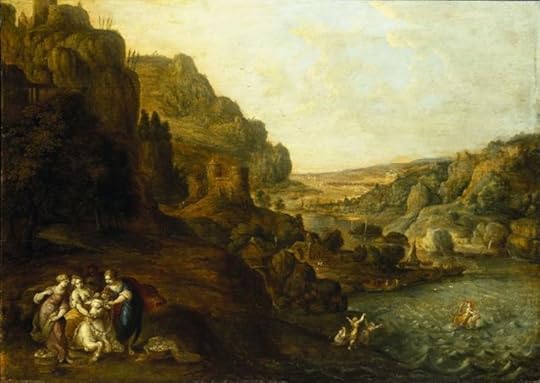
Herman van Swanevelt. 1610-50. Holburne Museum, Bath.
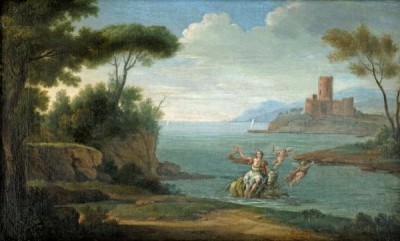
Hendrik van Minderhout. 1696. Musée des Beaux-Arts de Rouen

Books mentioned in this topic
Le bain de Diane (other topics)After Ovid: New Metamorphoses (other topics)
The Penelopiad (other topics)
Metamorphica (other topics)
The Penelopiad (other topics)
More...
Authors mentioned in this topic
Pierre Klossowski (other topics)Euripides (other topics)





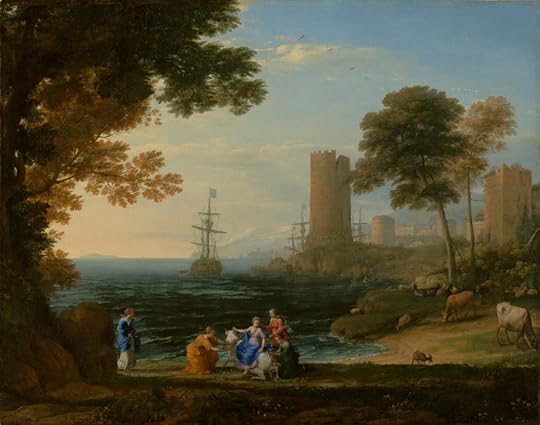


I saw this playing also on the fear, on the male side, of marrying a non virgin... I imagine with two concerns in mind - one sheer pleasure/ vanity for 'being the first and only one' but also for making sure the woman was not arriving to the marriage already pregnant.